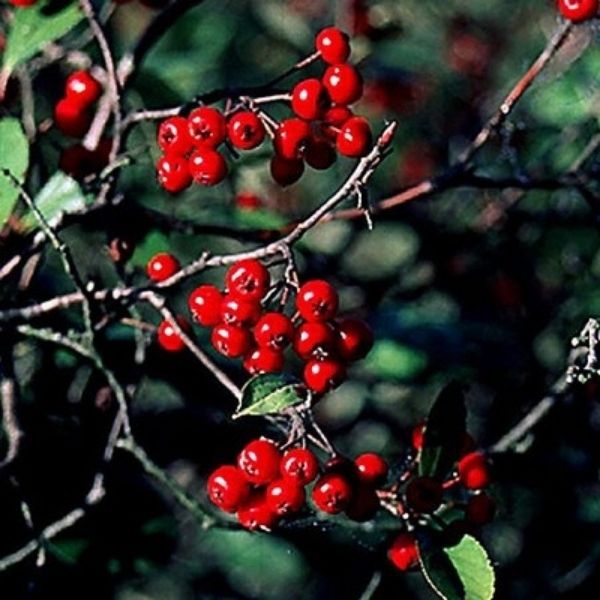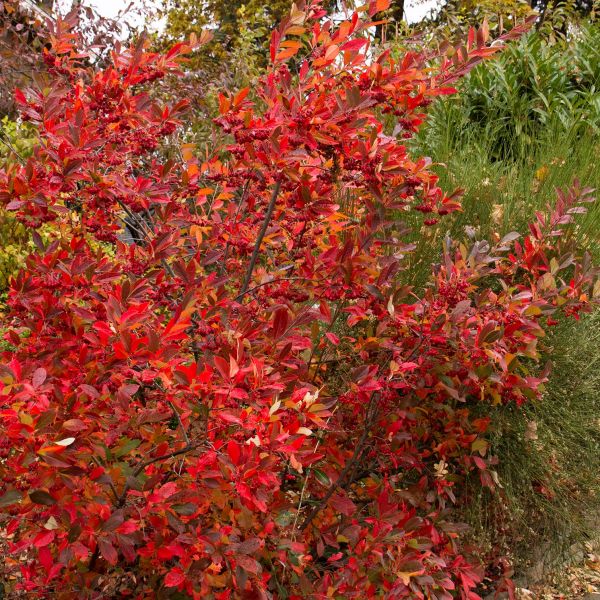

Red Chokeberry
Aronia arbutifolia 'Brilliantissima'
81 reviews
Red Chokeberry
Aronia arbutifolia 'Brilliantissima'
81 reviews
2.5 Gallon
We are sorry, product is currently out of stock due to seasonal availability. Please check the "Related plants available in your area" section below
Not just beautiful - intentionally selected by ShrubHub's 3D landscape design team to fit real-world spaces and maximize yard potential.
Why Red Chokeberry?
Red Chokeberry, also known as Aronia arbutifolia 'Brilliantissima', is a deciduous shrub that is highly valued for its ornamental beauty and attractive fruit. It features glossy green leaves that turn shades of red and purple in the fall, and clusters of small white flowers that bloom in the spring followed by bright red berries in the fall. It is a hardy and adaptable plant that is a great addition to gardens and landscapes.
Sunlight
Full sun to partial shade.
Watering
Red Chokeberry typically requires regular watering, especially during its first year of growth. It prefers moist soil that is well-draining. Adequate hydration is important for the plant's establishment and overall health.
Fertilizing
Red Chokeberry prefers acidic soil with a pH of 4.5 to 6.0. It benefits from organic matter like compost or aged manure. Slow-release fertilizers with balanced N-P-K ratios, such as 10-10-10, may be applied in early spring to promote healthy growth.
Enjoy Delicious Light Pink Berries With This Red Chokeberry Shrub
If you're looking for a hardy and beautiful plant that can add interest and nutrition to your landscape, look no further than the Red Chokeberry. This stunning deciduous shrub is sure to impress with its dark green leaves, showy white flowers, and bright red to light pink, edible berries.
Native to Eastern North America, the Red Chokeberry is a multi-stemmed shrub that provides many benefits that make it a valuable addition to any landscape.
One of the key benefits of the Red Chokeberry, Aronia arbutifolia brilliantissima, is its hardiness. This plant can thrive in a variety of soil types and weather conditions, making it a low-maintenance addition to your yard. It is also drought tolerant and resistant to shrub borders, so you can enjoy its beauty even in the driest of summers.
But the Red Chokeberry is more than just a hardy plant. It is also a valuable source of nutrition, with its berries rich in antioxidants and other beneficial nutrients. Enjoy the health benefits of this unique plant by incorporating its berries into your diet or using them to make jams and other preserves.
In addition to its hardiness and nutritional benefits, the Red Chokeberry also provides important environmental benefits. Its leaves absorb carbon dioxide and other pollutants from the air, improving air quality and reducing the effects of climate change. And its dense growth habit provides important habitat for birds and other wildlife.
But perhaps the greatest benefit of the Red Chokeberry is its ability to add interest and texture to your landscape. This plant is a unique and eye-catching addition to any garden or yard, with its showy white flowers and bright red berries. Plant it as a specimen plant or use it to create a natural privacy screen.
Plant Information:
| Botanical Name: | Aronia arbutifolia 'Brilliantissima' |
| USDA Zones: | 4 - 9 |
| Water: | Highly Adaptable |
| Exposure: | Full Sun |
| Soil Needs: | Well Drained Soil |
| Mature Height: | 6 - 10 feet |
| Mature Spread: | 3 - 5 feet |







Pollination Info
Pollination Information for Red Chokeberry (Aronia arbutifolia 'Brilliantissima')
The Red Chokeberry (Aronia arbutifolia 'Brilliantissima') is a deciduous shrub that belongs to the Rosaceae family. It can grow up to 8-10 feet in height and prefers to grow in moist, well-drained soil. The shrub is hardy in USDA zones 4-9.
Pollination of Red Chokeberry is dependent on the presence of both male and female flowers on the same plant. These flowers are hermaphrodite, with both male and female reproductive organs on the same flower. The Red Chokeberry flowers in mid to late spring, typically in May.
The Red Chokeberry is pollinated primarily by bees, including bumblebees, honeybees, and solitary bees. Butterflies and moths may also visit the flowers but are not as effective in pollination.
Cross-pollination can occur between different varieties of Red Chokeberry. However, the shrub is self-sterile and requires pollen from another plant to produce fruit. Therefore, it is recommended to plant multiple varieties of Red Chokeberry within close proximity to ensure successful pollination and fruit set.
The fruit of the Red Chokeberry is edible but astringent and usually used in jams, jellies, and sauces. It is a favorite food source for many birds, including the cedar waxwing, American robin, and woodpecker.
In summary, Red Chokeberry (Aronia arbutifolia 'Brilliantissima') is hermaphroditic and primarily pollinated by bees. It requires cross-pollination and the presence of both male and female flowers to produce fruit. Multiple varieties of the shrub should be planted within close proximity to ensure successful pollination and fruit set.
FAQ
Red Chokeberry (Aronia arbutifolia 'Brilliantissima') FAQ
What is Red Chokeberry?
Red Chokeberry, also known as Aronia arbutifolia 'Brilliantissima', is a deciduous shrub that produces red berries in the fall. It is native to North America and is commonly found in wetlands, swamps, and along streams and ponds.
How big does Red Chokeberry grow?
Red Chokeberry typically grows to be 6-10 feet tall and 5-8 feet wide.
When does Red Chokeberry bloom and fruit?
Red Chokeberry blooms in the spring with small white to pinkish flowers. The berries ripen in the fall and are bright red.
Is Red Chokeberry edible?
Yes, Red Chokeberry fruit is edible and can be used to make jams, jellies, and wine. However, the fruit is tart and astringent and is not typically eaten fresh.
Does Red Chokeberry attract wildlife?
Yes, Red Chokeberry is a valuable food source for wildlife. The berries are eaten by birds, which are attracted to the plant's bright red color, and the dense shrubbery provides cover for small animals.
How do you care for Red Chokeberry?
Red Chokeberry is a low maintenance plant that is easy to care for. It prefers moist, well-drained soil and partial to full sun. Prune any damaged or diseased branches in the spring and shape the plant as desired.
Can Red Chokeberry be used in landscaping?
Yes, Red Chokeberry is a great addition to a landscape. Its striking red berries and dense foliage make it a popular choice for mass plantings or as a specimen plant. It can also be used in rain gardens or to stabilize soil along streams or ponds.
Planting & Care
Planting Red Chokeberry (Aronia arbutifolia 'Brilliantissima')
- Choose an area with full sun to partial shade and well-drained soil.
- Dig a hole that is twice as wide and as deep as the root ball.
- Place the plant in the hole, making sure the top of the root ball is level with the soil surface.
- Backfill the hole with the soil and gently tamp down.
- Water thoroughly.
Caring for Red Chokeberry (Aronia arbutifolia 'Brilliantissima')
- Water regularly to keep the soil moist, but not waterlogged.
- Fertilize in early spring with a slow-release, balanced fertilizer.
- Prune in late winter or early spring to remove any dead or diseased wood.
- Protect from pests and diseases, such as aphids and powdery mildew, by maintaining good air circulation and removing any affected leaves or branches.
- Harvest the berries in the fall, if desired, for use in jams, jellies, or baked goods.
Check Out These Verified Customer Reviews:
Customer Reviews
4.7 out of 5 based on 81 reviews
Thank you! Your review has been submitted.
Beautiful plant, arrived in great condition.
Quality is outstanding, very happy with purchase.
Website was easy to navigate, found what I needed quickly.
Item has been added to your cart.


